Research on the Effect of Urbanization on China’s Carbon Emission Efficiency
Abstract
1. Introduction
2. Literature Review
3. Carbon Emission Efficiency Measurement and Result Analysis
3.1. The SBM Model
3.2. Research Indicators and Data Selection
3.3. Results Analysis of Carbon Emission Efficiency
4. Establishment of Measurement Model and Data Description
4.1. Original Model
4.2. Model Extension
4.3. Variable Description
4.3.1. Explained Variable
4.3.2. Core Explanatory Variable
4.3.3. Control Variables
4.4. Data Sources
5. Empirical Analysis
5.1. Regression Results Analysis at the National Level
5.2. Analysis of Regression Results in the Eastern, Central and Western Regions
6. Conclusions
Author Contributions
Funding
Conflicts of Interest
References
- China Meteorological Administration. Global Carbon Budget Report: Strong Recovery of Global Carbon Emissions in 2017 [EB/OL]. (2017.11.22) [2018.4.25]. Available online: http://www.cma.gov.cn/2011xwzx/2011xqhbh/2011xdtxx/201711/t20171122_456610.html (accessed on 25 April 2018).
- Wang, F.; Wang, C.; Su, Y.; Jin, L.; Wang, Y.; Zhang, X. Decomposition analysis of carbon emission factors from energy consumption in Guangdong province from 1990 to 2014. Sustainability 2017, 9, 274. [Google Scholar] [CrossRef]
- Zagheni, E. The leverage of demographic dynamics on carbon dioxide emissions: Does age structure matter? Demography 2011, 48, 371–399. [Google Scholar] [CrossRef] [PubMed]
- Lugauer, S.; Jensen, R.; Sadler, C. An estimate of the age distribution’s effect on carbon dioxide emissions. Econ. Inq. 2014, 52, 914–929. [Google Scholar] [CrossRef]
- Sun, M.; Wang, Y.; Shi, L.; Klemeš, J.J. Uncovering energy use, carbon emissions and environmental burdens of pulp and paper industry: A systematic review and meta-analysis. Renew. Sustain. Energy Rev. 2018, 92, 823–833. [Google Scholar] [CrossRef]
- Zeng, S.; Jiang, C.; Ma, C.; Su, B. Investment efficiency of the new energy industry in China. Energy Econ. 2018, 70, 536–544. [Google Scholar] [CrossRef]
- Li, M.; Mi, Z.; Coffman, D.M.; Wei, Y.M. Assessing the policy impacts on non-ferrous metals industry’s CO2 reduction: Evidence from China. J. Clean. Prod. 2018, 192, 252–261. [Google Scholar] [CrossRef]
- Cheng, Z.; Li, L.; Liu, J.; Zhang, H. Total-factor carbon emission efficiency of China’s provincial industrial sector and its dynamic evolution. Renew. Sustain. Energy Rev. 2018, 94, 330–339. [Google Scholar] [CrossRef]
- Meng, F.; Su, B.; Thomson, E.; Zhou, D.; Zhou, P. Measuring China’s regional energy and carbon emission efficiency with DEA models: A survey. Appl. Energy 2016, 183, 1–21. [Google Scholar] [CrossRef]
- Tian, X.; Chang, M.; Shi, F.; Tanikawa, H. Decoding the effect of socioeconomic transitions on carbon dioxide emissions: Analysis framework and application in megacity Chongqing from inland China. J. Clean. Prod. 2017, 142, 2114–2124. [Google Scholar] [CrossRef]
- Wang, Z.; Cui, C.; Peng, S. How do urbanization and consumption patterns affect carbon emissions in China? A decomposition analysis. J. Clean. Prod. 2019, 211, 1201–1208. [Google Scholar] [CrossRef]
- Ren, L.J.; Wang, W.J.; Wang, J.C.; Liu, R.T. Analysis of energy consumption and carbon emission during the urbanization of Shandong Province. J. Clean. Prod. 2015, 103, 534–541. [Google Scholar] [CrossRef]
- Miao, L. Examining the impact factors of urban residential energy consumption and CO2 emissions in China—Evidence from city-level data. Ecol. Indic. 2017, 73, 29–37. [Google Scholar] [CrossRef]
- Behera, S.R.; Dash, D.P. The effect of urbanization, energy consumption, and foreign direct investment on the carbon dioxide emission in the SSEA (South and Southeast Asian) region. Renew. Sustain. Energy Rev. 2017, 70, 96–106. [Google Scholar] [CrossRef]
- Franco, S.; Mandla, V.R.; Rao, K.R.M. Urbanization, energy consumption and emissions in the Indian context a review. Renew. Sustain. Energy Rev. 2017, 71, 898–907. [Google Scholar] [CrossRef]
- Fang, Q.Y.; Tao, S.L. Research on driving factors of China’s carbon emissions from the perspective of population and urbanization. Contemp. Financ. Econ. 2017, 3, 14–25. [Google Scholar]
- Zhang, W.J.; Xu, H.Z. Effects of land urbanization and land finance on carbon emissions: A panel data analysis for Chinese provinces. Land Use Policy 2017, 63, 493–500. [Google Scholar] [CrossRef]
- Ali, H.S.; Abdul-Rahim, A.S.; Ribadu, M.B. Urbanization and carbon dioxide emissions in Singapore: Evidence from the ARDL approach. Environ. Sci. Pollut. Res. 2017, 24, 1967–1974. [Google Scholar] [CrossRef] [PubMed]
- Zhang, T.F.; Yang, J.; Sheng, P. Impact of urbanization on China’s carbon emissions and its effect channels. Chin. J. Popul. Resour. Environ. 2016, 26, 47–57. [Google Scholar]
- Bilgili, F.; Koçak, E.; Bulut, Ü.; Kuloğlu, A. The impact of urbanization on energy intensity: Panel data evidence considering cross-sectional dependence and heterogeneity. Energy 2017, 133, 242–256. [Google Scholar] [CrossRef]
- Martínez-Zarzoso, I.; Maruotti, A. The impact of urbanization on CO2 emissions: Evidence from developing countries. Ecol. Econ. 2017, 70, 1344–1353. [Google Scholar] [CrossRef]
- Cao, Z.; Wei, J.; Chen, H.-B. CO2 emissions and urbanization correlation in China based on threshold analysis. Ecol. Indic. 2016, 61, 193–201. [Google Scholar]
- Wang, Y.; Kang, Y.; Wang, J.; Xu, L. Panel estimation for the impacts of population-related factors on CO2 emissions: A regional analysis in China. Ecol. Indic. 2017, 78, 322–330. [Google Scholar] [CrossRef]
- He, Z.; Xu, S.; Shen, W.; Long, R.; Chen, H. Impact of urbanization on energy related CO2 emission at different development levels: Regional difference in China based on panel estimation. J. Clean. Prod. 2017, 140, 1719–1730. [Google Scholar] [CrossRef]
- Charnes, A.; Cooper, W.W.; Rhodes, E. Measuring the efficiency of decision making units. Eur. J. Oper. Res. 1978, 2, 429–444. [Google Scholar] [CrossRef]
- Tone, K. A slacks-based measure of efficiency in data envelopment analysis. Eur. J. Oper. Res. 2001, 130, 498–509. [Google Scholar] [CrossRef]
- Wang, Y.; Liu, H.; Mao, G.; Zuo, J.; Ma, J. Inter-regional and sectoral linkage analysis of air pollution in Beijing–Tianjin–Hebei (Jing-Jin-Ji) urban agglomeration of China. J. Clean. Prod. 2017, 165, 1436–1444. [Google Scholar] [CrossRef]
- Ehrlich, P.R.; Holdren, J.P. Impact of Population Growth. Science 1971, 171, 1212–1217. [Google Scholar] [CrossRef]
- Dietz, T.; Rosa, E.A. Effects of Population and Affluence on CO2 Emissions. Proc. Natl. Acad. Sci. USA 1997, 94, 175–179. [Google Scholar] [CrossRef]
- Wang, X.; Liu, G.L. Empirical analysis of the impact of population size and structure in gansu province on carbon emissions—Based on the extended STIRPAT model. J. Lanzhou Univ. (Soc. Sci.) 2014, 42, 127–132. [Google Scholar]
- Ma, X.Y.; Li, Q.Y.; Guo, Y.Y. Influence of population on carbon emission in China—Analysis based on STIRPAT model. Popul. Econ. 2013, 1, 44–51. [Google Scholar]
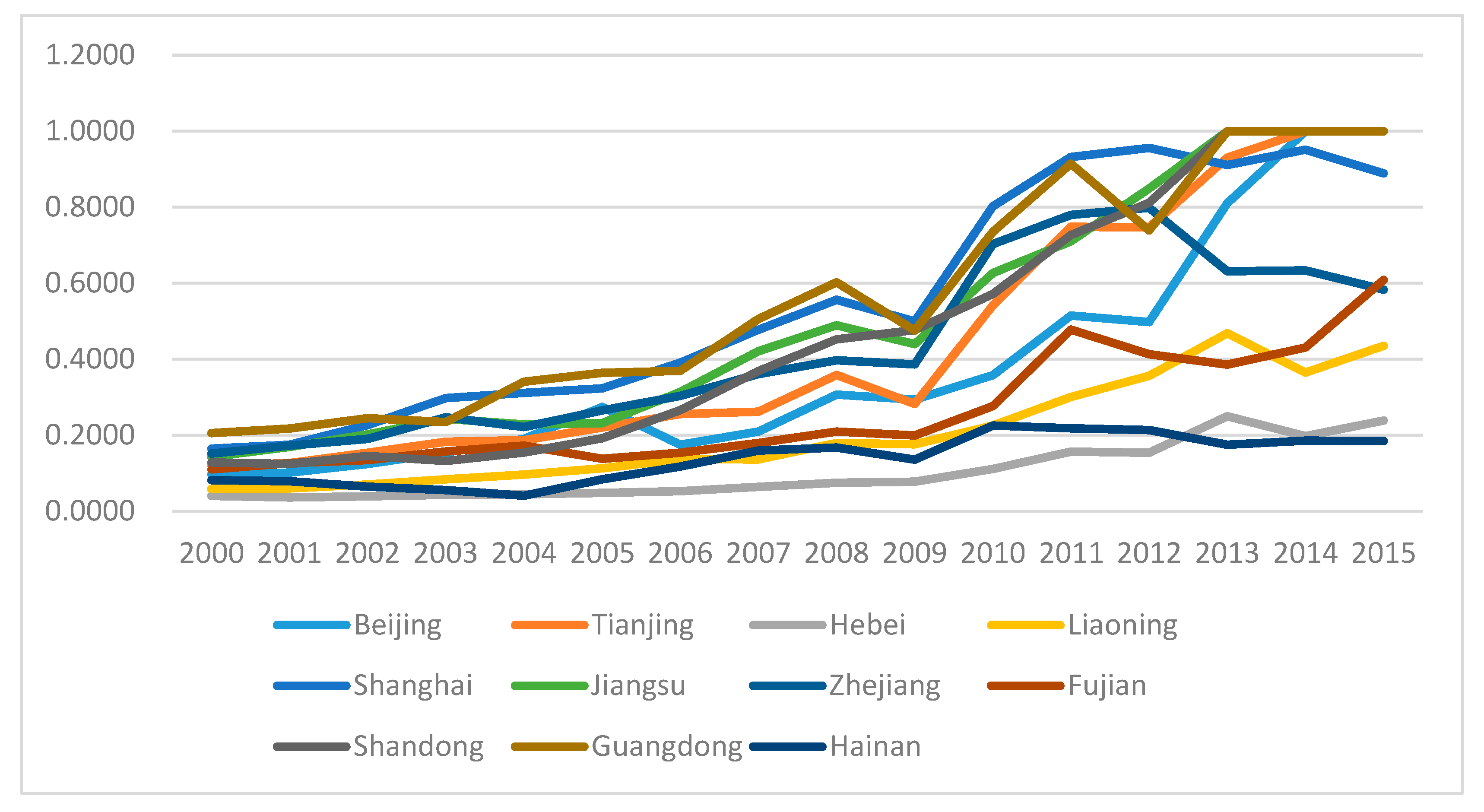
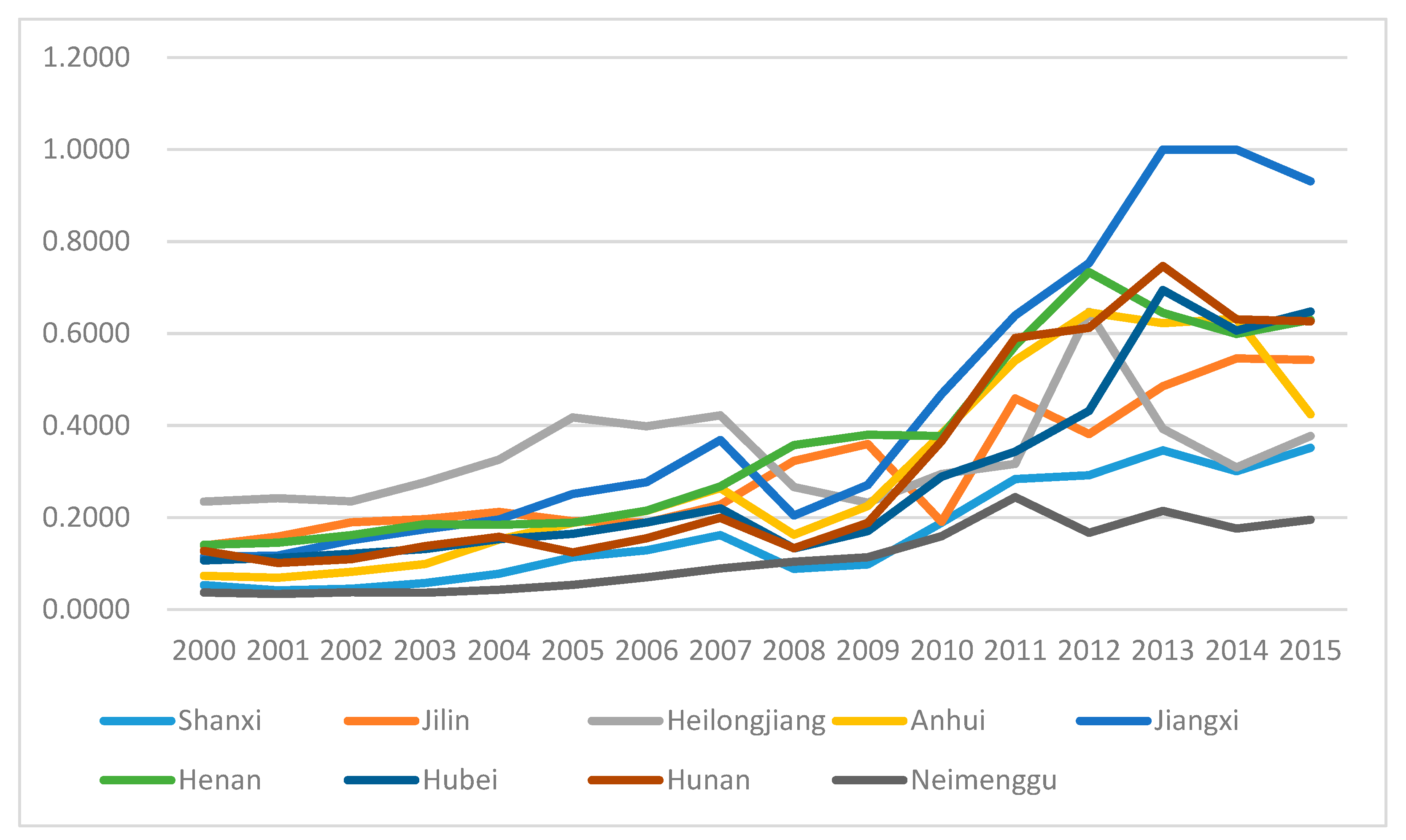
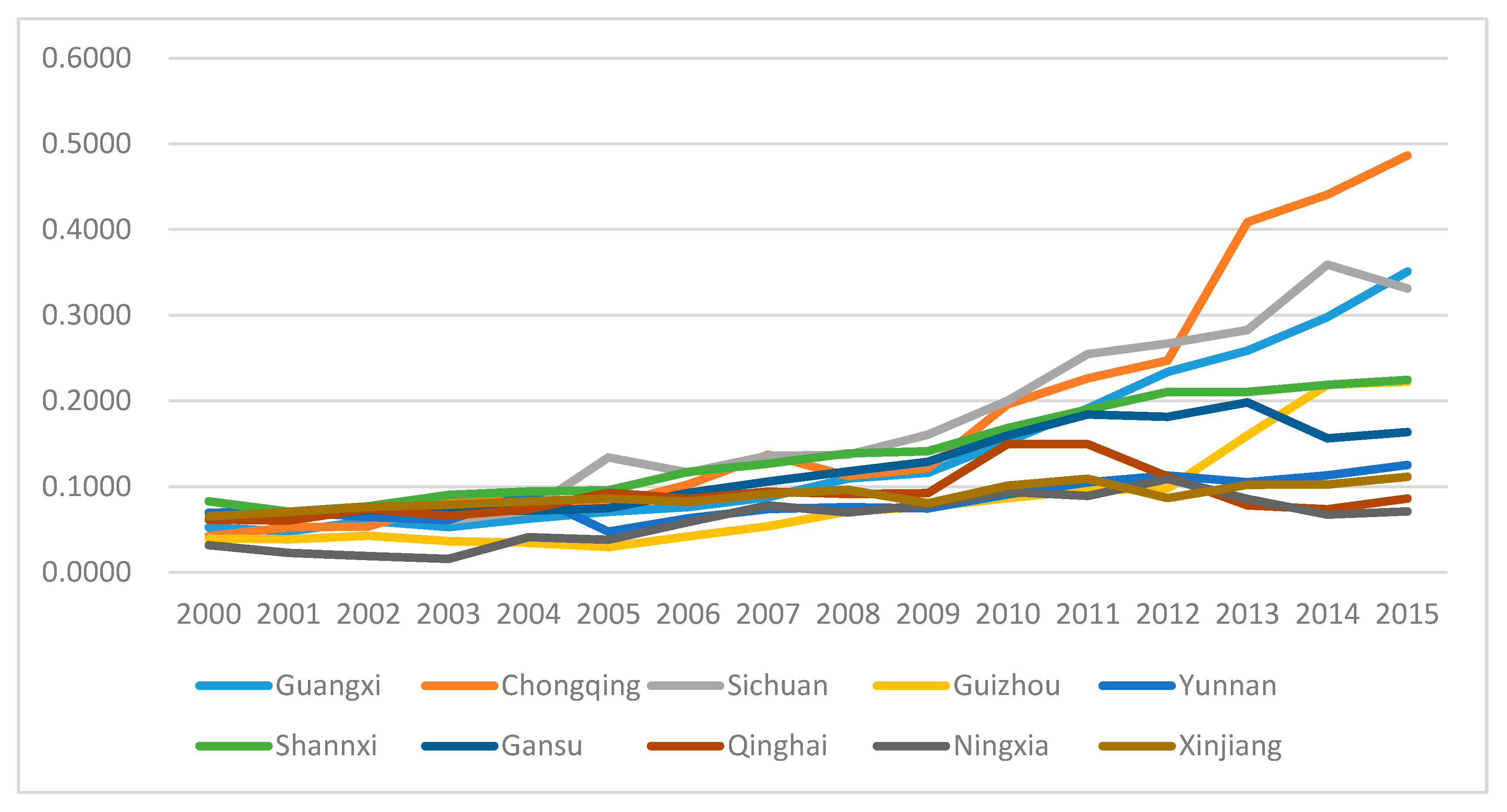
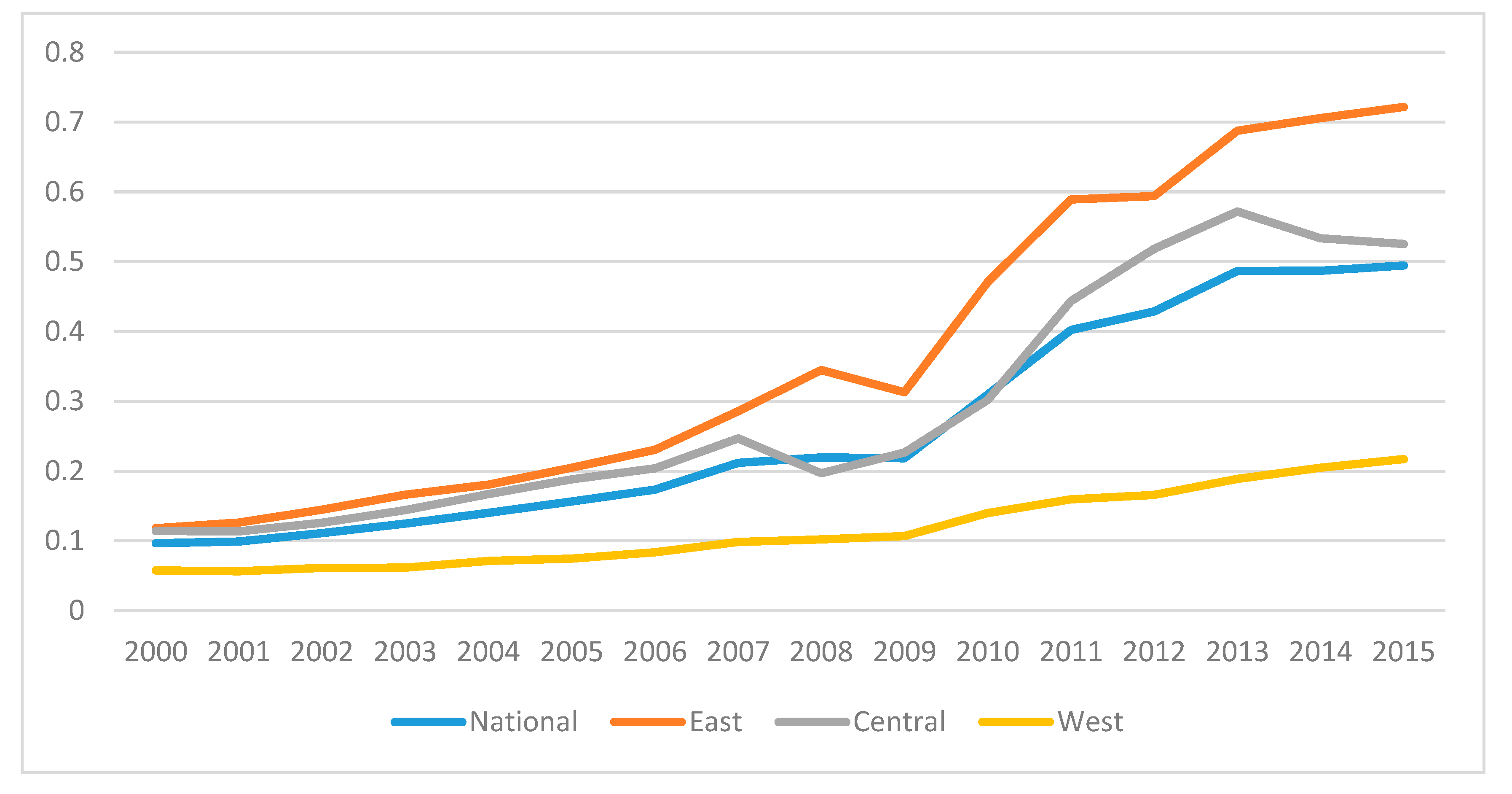
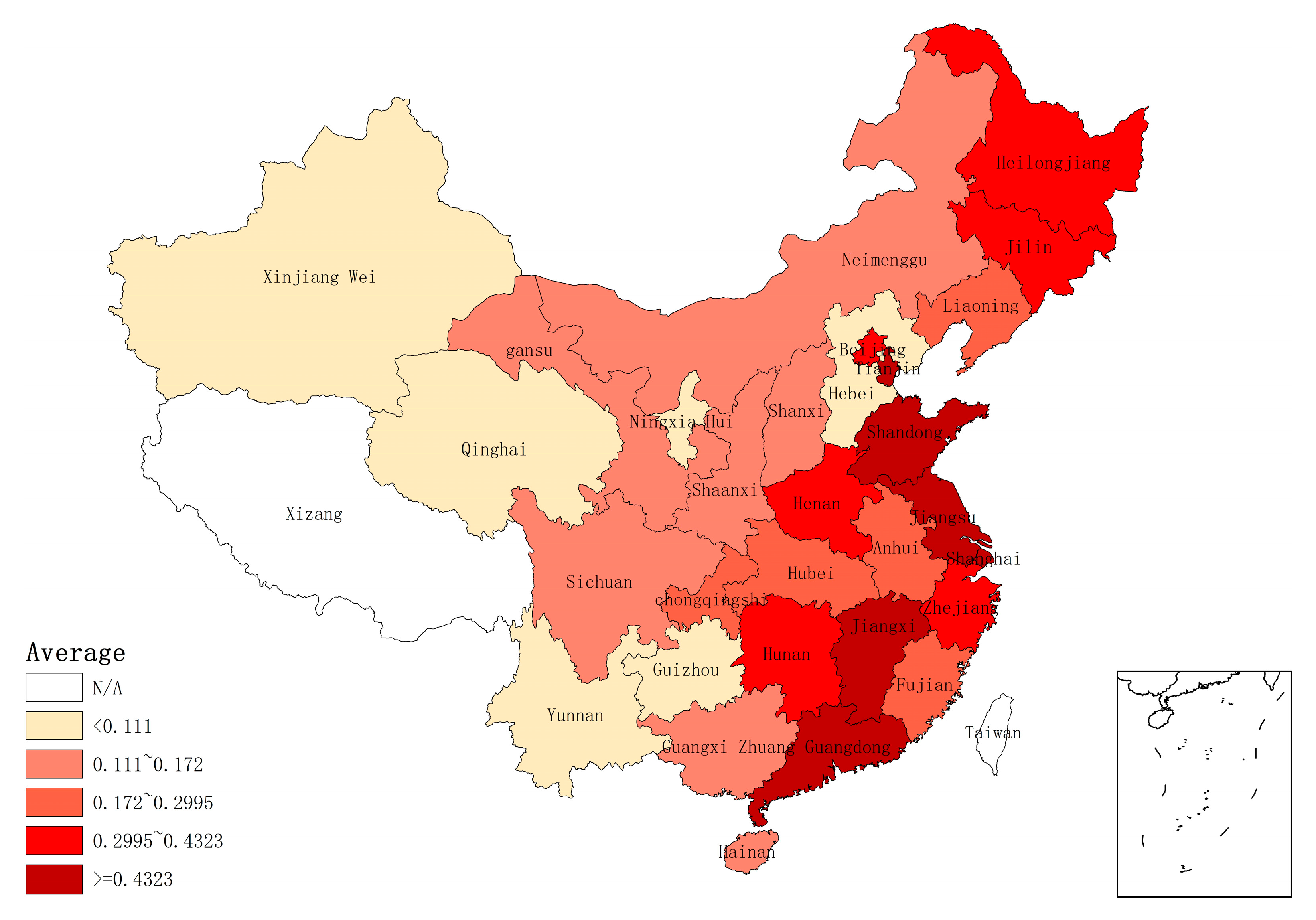
| Categories | Variables | The Proxy Variables | Unit | Max | Min | Standard Deviation | The Mean |
|---|---|---|---|---|---|---|---|
| Input | Capital | Net fixed assets | Hundred million RMB | 35,587.4 | 160.46 | 6791.101 | 6751.503 |
| Labour | The number of jobs | Ten thousand people | 6726.0 | 275.5 | 1679.449 | 2495.408 | |
| Energy | Total energy consumption | Ten thousand tons standard coal | 85,857.509 | 399.360 | 9720.539 | 11,892.351 | |
| Output | GDP | —— | One hundred million RMB | 80,854.91 | 263.59 | 13,346.559 | 12,507.752 |
| CO2 | —— | Ten thousand tons of | 54,295.632 | 239.269 | 6868.665 | 8361.558 |
| Year | 2000 | 2001 | 2002 | 2003 | 2004 | 2005 | 2006 | 2007 | 2008 | 2009 | 2010 | 2011 | 2012 | 2013 | 2014 | 2015 |
|---|---|---|---|---|---|---|---|---|---|---|---|---|---|---|---|---|
| Beijing | 0.097 | 0.102 | 0.124 | 0.154 | 0.190 | 0.274 | 0.175 | 0.209 | 0.307 | 0.293 | 0.358 | 0.515 | 0.498 | 0.810 | 1.000 | 1.000 |
| Tianjin | 0.120 | 0.126 | 0.154 | 0.183 | 0.187 | 0.220 | 0.255 | 0.262 | 0.359 | 0.282 | 0.541 | 0.748 | 0.747 | 0.930 | 1.000 | 1.000 |
| Hebei | 0.040 | 0.037 | 0.039 | 0.043 | 0.045 | 0.048 | 0.053 | 0.064 | 0.075 | 0.078 | 0.111 | 0.156 | 0.154 | 0.250 | 0.198 | 0.239 |
| Liaoning | 0.059 | 0.060 | 0.070 | 0.084 | 0.097 | 0.113 | 0.137 | 0.136 | 0.179 | 0.176 | 0.226 | 0.301 | 0.356 | 0.468 | 0.365 | 0.435 |
| Shanghai | 0.165 | 0.175 | 0.226 | 0.298 | 0.311 | 0.323 | 0.391 | 0.477 | 0.556 | 0.499 | 0.802 | 0.932 | 0.956 | 0.911 | 0.951 | 0.889 |
| Jiangsu | 0.143 | 0.169 | 0.202 | 0.243 | 0.228 | 0.232 | 0.314 | 0.421 | 0.489 | 0.439 | 0.627 | 0.710 | 0.849 | 1.000 | 1.000 | 1.000 |
| Zhejiang | 0.152 | 0.173 | 0.190 | 0.247 | 0.222 | 0.265 | 0.303 | 0.360 | 0.397 | 0.386 | 0.703 | 0.780 | 0.799 | 0.631 | 0.633 | 0.583 |
| Fujian | 0.110 | 0.126 | 0.134 | 0.157 | 0.172 | 0.138 | 0.154 | 0.179 | 0.210 | 0.199 | 0.276 | 0.478 | 0.413 | 0.386 | 0.431 | 0.609 |
| Shandong | 0.128 | 0.124 | 0.145 | 0.132 | 0.154 | 0.192 | 0.266 | 0.369 | 0.452 | 0.477 | 0.571 | 0.727 | 0.811 | 1.000 | 1.000 | 1.000 |
| Guangdong | 0.205 | 0.218 | 0.244 | 0.235 | 0.341 | 0.364 | 0.369 | 0.506 | 0.602 | 0.475 | 0.735 | 0.914 | 0.739 | 1.000 | 1.000 | 1.000 |
| Hainan | 0.082 | 0.079 | 0.064 | 0.055 | 0.041 | 0.084 | 0.117 | 0.159 | 0.167 | 0.136 | 0.226 | 0.218 | 0.214 | 0.175 | 0.185 | 0.184 |
| Shanxi | 0.053 | 0.042 | 0.046 | 0.058 | 0.078 | 0.114 | 0.129 | 0.162 | 0.088 | 0.098 | 0.189 | 0.284 | 0.292 | 0.346 | 0.301 | 0.352 |
| Jilin | 0.140 | 0.159 | 0.190 | 0.196 | 0.212 | 0.192 | 0.189 | 0.228 | 0.323 | 0.360 | 0.191 | 0.459 | 0.381 | 0.485 | 0.546 | 0.543 |
| Heilongjiang | 0.235 | 0.242 | 0.235 | 0.277 | 0.326 | 0.418 | 0.399 | 0.422 | 0.266 | 0.233 | 0.295 | 0.317 | 0.648 | 0.393 | 0.309 | 0.377 |
| Anhui | 0.073 | 0.070 | 0.082 | 0.099 | 0.152 | 0.188 | 0.214 | 0.264 | 0.163 | 0.225 | 0.382 | 0.541 | 0.646 | 0.622 | 0.632 | 0.424 |
| Jiangxi | 0.115 | 0.117 | 0.151 | 0.175 | 0.196 | 0.251 | 0.277 | 0.369 | 0.204 | 0.271 | 0.468 | 0.639 | 0.753 | 1.000 | 1.000 | 0.931 |
| Henan | 0.141 | 0.145 | 0.162 | 0.185 | 0.184 | 0.189 | 0.215 | 0.268 | 0.357 | 0.380 | 0.377 | 0.574 | 0.734 | 0.645 | 0.599 | 0.630 |
| Hubei | 0.107 | 0.112 | 0.122 | 0.131 | 0.153 | 0.165 | 0.189 | 0.220 | 0.133 | 0.171 | 0.289 | 0.343 | 0.432 | 0.695 | 0.606 | 0.648 |
| Hunan | 0.127 | 0.101 | 0.110 | 0.138 | 0.158 | 0.124 | 0.155 | 0.199 | 0.133 | 0.189 | 0.366 | 0.591 | 0.613 | 0.747 | 0.631 | 0.627 |
| Neimenggu | 0.037 | 0.034 | 0.038 | 0.037 | 0.043 | 0.053 | 0.070 | 0.089 | 0.104 | 0.114 | 0.159 | 0.245 | 0.167 | 0.214 | 0.176 | 0.195 |
| Guangxi | 0.052 | 0.048 | 0.060 | 0.053 | 0.063 | 0.071 | 0.076 | 0.088 | 0.109 | 0.116 | 0.153 | 0.191 | 0.234 | 0.259 | 0.298 | 0.351 |
| Chongqing | 0.043 | 0.052 | 0.054 | 0.082 | 0.088 | 0.079 | 0.102 | 0.137 | 0.113 | 0.121 | 0.196 | 0.226 | 0.247 | 0.409 | 0.441 | 0.486 |
| Sichuan | 0.068 | 0.070 | 0.073 | 0.061 | 0.072 | 0.134 | 0.116 | 0.136 | 0.137 | 0.161 | 0.200 | 0.255 | 0.267 | 0.283 | 0.359 | 0.331 |
| Quizhou | 0.040 | 0.039 | 0.043 | 0.036 | 0.034 | 0.030 | 0.042 | 0.054 | 0.071 | 0.076 | 0.087 | 0.096 | 0.098 | 0.160 | 0.219 | 0.222 |
| Yunnan | 0.069 | 0.071 | 0.065 | 0.061 | 0.092 | 0.048 | 0.063 | 0.074 | 0.076 | 0.075 | 0.091 | 0.105 | 0.113 | 0.105 | 0.113 | 0.125 |
| Shanxi | 0.083 | 0.071 | 0.077 | 0.090 | 0.094 | 0.096 | 0.117 | 0.127 | 0.139 | 0.141 | 0.168 | 0.190 | 0.211 | 0.211 | 0.219 | 0.225 |
| Gansu | 0.065 | 0.063 | 0.073 | 0.072 | 0.072 | 0.075 | 0.093 | 0.106 | 0.118 | 0.129 | 0.160 | 0.184 | 0.181 | 0.198 | 0.156 | 0.164 |
| Qinghai | 0.062 | 0.060 | 0.074 | 0.066 | 0.074 | 0.093 | 0.086 | 0.094 | 0.091 | 0.092 | 0.150 | 0.150 | 0.112 | 0.078 | 0.074 | 0.086 |
| Ningxia | 0.032 | 0.023 | 0.019 | 0.016 | 0.041 | 0.038 | 0.059 | 0.078 | 0.070 | 0.079 | 0.094 | 0.089 | 0.109 | 0.086 | 0.067 | 0.071 |
| Xinjiang | 0.065 | 0.071 | 0.076 | 0.079 | 0.083 | 0.086 | 0.082 | 0.092 | 0.096 | 0.081 | 0.101 | 0.109 | 0.087 | 0.102 | 0.102 | 0.112 |
| The Eastern Region | Carbon Emission Efficiency | Ranking | The Central Region | Carbon Emission Efficiency | Ranking | The Western Region | Carbon Emission Efficiency | Ranking |
|---|---|---|---|---|---|---|---|---|
| Beijing | 0.382 | 8 | Shanxi | 0.164 | 19 | Inner Mongolia | 0.111 | 24 |
| Tianjin | 0.445 | 5 | Jilin | 0.299 | 12 | Guangxi | 0.139 | 21 |
| Hebei | 0.102 | 25 | Heilongjiang | 0.337 | 10 | Chongqing | 0.180 | 17 |
| Liaoning | 0.204 | 16 | Anhui | 0.299 | 13 | Sichuan | 0.170 | 18 |
| Shanghai | 0.554 | 2 | Jiangxi | 0.432 | 6 | Guizhou | 0.084 | 28 |
| Jiangsu | 0.504 | 3 | Henan | 0.362 | 9 | Yunnan | 0.084 | 29 |
| Zhejiang | 0.427 | 7 | Hubei | 0.282 | 14 | Shaanxi | 0.141 | 20 |
| Fujian | 0.261 | 15 | Hunan | 0.313 | 11 | Gansu | 0.119 | 23 |
| Shandong | 0.472 | 4 | Qinghai | 0.090 | 26 | |||
| Guangdong | 0.559 | 1 | Ningxia | 0.061 | 30 | |||
| Hainan | 0.137 | 22 | Xinjiang | 0.089 | 27 | |||
| Mean | 0.368 | 0.311 | 0.115 |
| Variable Symbols | Variable Names | Sample Size | Average Value | Maximum Value | Minimum Value | Standard Deviation |
|---|---|---|---|---|---|---|
| I | Carbon emission efficiency | 480 | 0.260 | 1.000 | 0.0157 | 0.241 |
| U | Urbanization rate | 480 | 0.489 | 0.896 | 0.233 | 0.153 |
| P | Population density | 480 | 0.431 | 0.985 | 0.0517 | 0.255 |
| A | Economic development level | 480 | 0.275 | 1.080 | 0.0266 | 0.216 |
| E | Energy intensity | 480 | 1.354 | 5.229 | 0.298 | 0.826 |
| S | Industrial structure | 480 | 0.469 | 0.615 | 0.197 | 0.0766 |
| Variables | I (FGLS) | II (Sys-GMM) | III (ML) | V (Spatial-GMM) |
|---|---|---|---|---|
| (time lag term) | 0.425 *** (5.165) | 0.137 *** (3.275) | ||
| (Spatial lag term) | 0.325 *** (5.286) | 0.014 ** (2.172) | ||
| urban | 0.719 *** | 0.906 *** | 0.598 * | 0.831 *** |
| (2.697) | (3.253) | (1.731) | (3.618) | |
| population | 0.233 *** | 0.216 *** | 0.278 *** | 0.237 *** |
| (4.180) | (3.725) | (4.580) | (4.081) | |
| pgdp | −0.061 * | −0.054 | −0.047 * | −0.052 ** |
| (−1.787) | (−1.119) | (−1.812) | (−2.125) | |
| structure | −0.762 | −0.981** | −0.637 | −0.707 *** |
| (−1.306) | (−2.064) | (−1.152) | (−2.545) | |
| energy | −0.482 *** | −1.106 *** | −0.966 *** | −1.003 *** |
| (−5.279) | (−4.871) | (−5.198) | (−5.105) | |
| _cons | −1.089 *** | −1.178 *** | −1.436 *** | −1.926 *** |
| (−6.724) | (−7.104) | (−5.813) | (−7.724) | |
| AR(1) | −3.42 | −3.86 | ||
| Test(p) | (0.001) | (0.000) | ||
| AR(2) | −1.23 | −1.28 | ||
| Test(p) | (0.22) | (0.19) | ||
| Hansen | 27.81 | 28.26 | ||
| Test(p) | (1.000) | (1.000) | ||
| N | 450 | 420 | 450 | 420 |
| Variables | Eastern Region | Western Region | Central Region |
|---|---|---|---|
| (Spatial-GMM) | (Spatial-GMM) | (Spatial-GMM) | |
| (time lag term) | 0.145 *** (3.417) | 0.136 *** (3.286) | 0.127 *** (3.069) |
| (Spatial lag term) | 0.017 *** (2.673) | 0.015 ** (2.147) | 0.011 * (1.775) |
| Urban | 0.742 | 0.796 ** | 0.883 *** |
| (1.406) | (2.185) | (2.927) | |
| Population | 0.286 *** | 0.242 *** | 0.211 *** |
| (4.741) | (4.170) | (3.635) | |
| Pgdp | −0.039 | −0.050 ** | −0.058 *** |
| (−1.507) | (−2.173) | (−2.619) | |
| Structure | −0.762 *** | −0.711 ** | −0.675 |
| (−2.614) | (−2.175) | (−1.490) | |
| Energy | −1.021 *** | −1.067 *** | −0.086 *** |
| (−5.186) | (−5.364) | (−5.027) | |
| _cons | −1.906 *** | −2.052 *** | −2.136 *** |
| (−7.423) | (−7.658) | (−8.035) | |
| AR(1) | −3.46 | −3.74 | −3.62 |
| Test(p) | (0.001) | (0.000) | (0.000) |
| AR(2) | −1.25 | −1.29 | −1.22 |
| Test(p) | (0.21) | (0.20) | (0.24) |
| Hansen | 23.25 | 24.41 | 25.07 |
| Test(p) | (1.000) | (1.000) | (1.000) |
| N | 165 | 165 | 120 |
© 2019 by the authors. Licensee MDPI, Basel, Switzerland. This article is an open access article distributed under the terms and conditions of the Creative Commons Attribution (CC BY) license (http://creativecommons.org/licenses/by/4.0/).
Share and Cite
Li, L.; Cai, Y.; Liu, L. Research on the Effect of Urbanization on China’s Carbon Emission Efficiency. Sustainability 2020, 12, 163. https://doi.org/10.3390/su12010163
Li L, Cai Y, Liu L. Research on the Effect of Urbanization on China’s Carbon Emission Efficiency. Sustainability. 2020; 12(1):163. https://doi.org/10.3390/su12010163
Chicago/Turabian StyleLi, Lianshui, Yang Cai, and Liang Liu. 2020. "Research on the Effect of Urbanization on China’s Carbon Emission Efficiency" Sustainability 12, no. 1: 163. https://doi.org/10.3390/su12010163
APA StyleLi, L., Cai, Y., & Liu, L. (2020). Research on the Effect of Urbanization on China’s Carbon Emission Efficiency. Sustainability, 12(1), 163. https://doi.org/10.3390/su12010163




